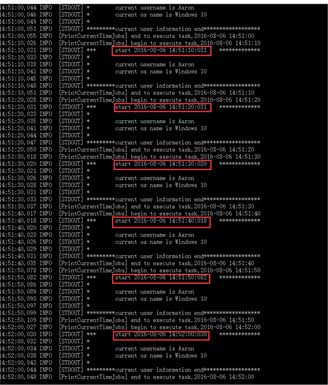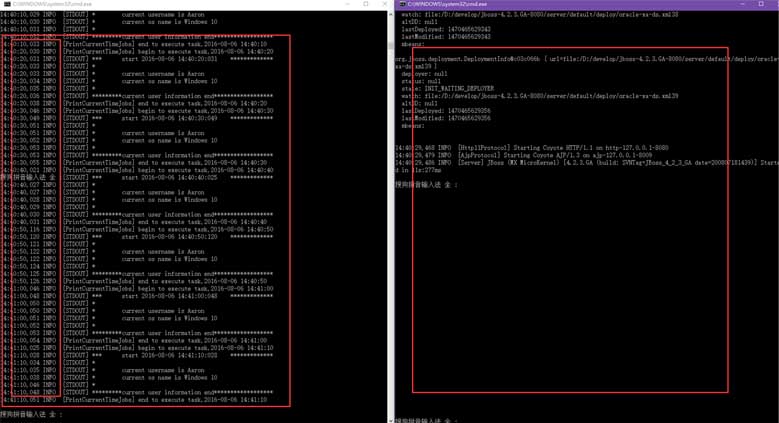問題背景
我公司是一個快速發展的創業公司,目前有200人,主要業務是旅遊和酒店相關的,應用迭代更新周期比較快,因此,開發人員花了更多的時間去更=跟上迭代的步伐,而缺乏了對整個系統的把控
沒有集群之前,公司定時任務的實現方式
在初期應用的訪問量並不是那麼大,一台伺服器完全滿足使用,應用中有很多定時任務需要執行
有了叢集之後,公司定時任務實現的方式
隨著用戶的增加,訪問量也就隨之增加,一台伺服器滿足不了高並發的要求,因此公司把應用給部署到在叢集中,前端透過nginx代理(應用程式伺服器ip可能是用防火牆進行了隔離,避免了直接使用ip+連接埠+應用程式名稱存取的方式)。
在叢集環境中,同樣的定時任務,在叢集中的每台機器都會執行,這樣定時任務就會重複執行,不但會增加伺服器的負擔,還會因為定時任務重複執行造成額外的不可預期的錯誤,因此公司的解決方案是:根據集群的數量,來把定時任務中的任務平均分到集群中的每台機器上(這裡的平均分是指以前一個定時任務本來是在一台機器上運行,先在人為的把這個任務分成幾部分,讓所有的機器都去執行這個人去)
目前集群中定時任務實現方式的缺陷
目前公司在集群中處理定時任務的方式不是正真的分散式處理方式,而是一種偽分散式(公司內部俗稱土方法),這種方式存在一個明顯的缺陷就是當集群中機器宕機,那麼整個定時任務就會掛掉或者不能一次性跑完,會對業務產生嚴重的影響
針對缺陷的解決方案(本文的重點之處)
利用spring+quartz構建一套真正的分佈式定時任務系統,經過查閱相關資料得知:quartz框架是原生就支援分散式定時任務的
開發IDE:Intellij IDEA
JDK版本:1.8
Spring版本:4.2.6
Quartz版本:2.2.1語化。
<?xml version="1.0" encoding="UTF-8"?>
<beans xmlns="http://www.springframework.org/schema/beans"
xmlns:xsi="http://www.w3.org/2001/XMLSchema-instance" xmlns:context="http://www.springframework.org/schema/context"
xsi:schemaLocation="http://www.springframework.org/schema/beans
http://www.springframework.org/schema/beans/spring-beans-4.0.xsd http://www.springframework.org/schema/context http://www.springframework.org/schema/context/spring-context.xsd">
<context:component-scan base-package="com.aaron.clusterquartz.job"/>
<bean name="dataSource" class="org.springframework.jndi.JndiObjectFactoryBean">
<!-- tomcat -->
<!--<property name="jndiName" value="java:comp/env/jndi/mysql/quartz"/>-->
<!-- jboss -->
<property name="jndiName" value="jdbc/quartz"/>
</bean>
<!-- 分布式事务配置 start -->
<!-- 配置线程池-->
<bean name="executor" class="org.springframework.scheduling.concurrent.ThreadPoolTaskExecutor">
<property name="corePoolSize" value="15"/>
<property name="maxPoolSize" value="25"/>
<property name="queueCapacity" value="100"/>
</bean>
<bean name="transactionManager" class="org.springframework.jdbc.datasource.DataSourceTransactionManager">
<property name="dataSource" ref="dataSource"/>
</bean>
<!-- 配置调度任务-->
<bean name="quartzScheduler" class="org.springframework.scheduling.quartz.SchedulerFactoryBean">
<property name="configLocation" value="classpath:quartz.properties"/>
<property name="dataSource" ref="dataSource"/>
<property name="transactionManager" ref="transactionManager"/>
<!-- 任务唯一的名称,将会持久化到数据库-->
<property name="schedulerName" value="baseScheduler"/>
<!-- 每台集群机器部署应用的时候会更新触发器-->
<property name="overwriteExistingJobs" value="true"/>
<property name="applicationContextSchedulerContextKey" value="appli"/>
<property name="jobFactory">
<bean class="com.aaron.clusterquartz.autowired.AutowiringSpringBeanJobFactory"/>
</property>
<property name="triggers">
<list>
<ref bean="printCurrentTimeScheduler"/>
</list>
</property>
<property name="jobDetails">
<list>
<ref bean="printCurrentTimeJobs"/>
</list>
</property>
<property name="taskExecutor" ref="executor"/>
</bean>
<!-- 配置Job详情 -->
<bean name="printCurrentTimeJobs" class="org.springframework.scheduling.quartz.JobDetailFactoryBean">
<property name="jobClass" value="com.aaron.clusterquartz.job.PrintCurrentTimeJobs"/>
<!--因为我使用了spring的注解,所以这里可以不用配置scheduler的属性-->
<!--<property name="jobDataAsMap">
<map>
<entry key="clusterQuartz" value="com.aaron.framework.clusterquartz.job.ClusterQuartz"/>
</map>
</property>-->
<property name="durability" value="true"/>
<property name="requestsRecovery" value="false"/>
</bean>
<!-- 配置触发时间 -->
<bean name="printCurrentTimeScheduler" class="com.aaron.clusterquartz.cron.PersistableCronTriggerFactoryBean">
<property name="jobDetail" ref="printCurrentTimeJobs"/>
<property name="cronExpression">
<value>0/10 * * * * ?</value>
</property>
<property name="timeZone">
<value>GMT+8:00</value>
</property>
</bean>
<!-- 分布式事务配置 end -->
</beans>AutowiringSpringBeanJobFactory類是為了可以在scheduler中使用spring註解,如果不使用註解,可以不適用該類,而直接使用
SpringBeanJobFactory#============================================================================ # Configure JobStore # Using Spring datasource in quartzJobsConfig.xml # Spring uses LocalDataSourceJobStore extension of JobStoreCMT #============================================================================ org.quartz.jobStore.useProperties=true org.quartz.jobStore.tablePrefix = QRTZ_ org.quartz.jobStore.isClustered = true org.quartz.jobStore.clusterCheckinInterval = 5000 org.quartz.jobStore.misfireThreshold = 60000 org.quartz.jobStore.txIsolationLevelReadCommitted = true # Change this to match your DB vendor org.quartz.jobStore.class = org.quartz.impl.jdbcjobstore.JobStoreTX org.quartz.jobStore.driverDelegateClass = org.quartz.impl.jdbcjobstore.StdJDBCDelegate #============================================================================ # Configure Main Scheduler Properties # Needed to manage cluster instances #============================================================================ org.quartz.scheduler.instanceId=AUTO org.quartz.scheduler.instanceName=MY_CLUSTERED_JOB_SCHEDULER org.quartz.scheduler.rmi.export = false org.quartz.scheduler.rmi.proxy = false #============================================================================ # Configure ThreadPool #============================================================================ org.quartz.threadPool.class = org.quartz.simpl.SimpleThreadPool org.quartz.threadPool.threadCount = 10 org.quartz.threadPool.threadPriority = 5 org.quartz.threadPool.threadsInheritContextClassLoaderOfInitializingThread = true
這個關了正在跑定時任務的端口後,之前的另一個沒有跑的端口開始接管,繼續運行定時任務
至此,我們可以清楚地看到,在分佈式定時任務中(或者集群),同一時刻只會有一個定時任務運行。 




